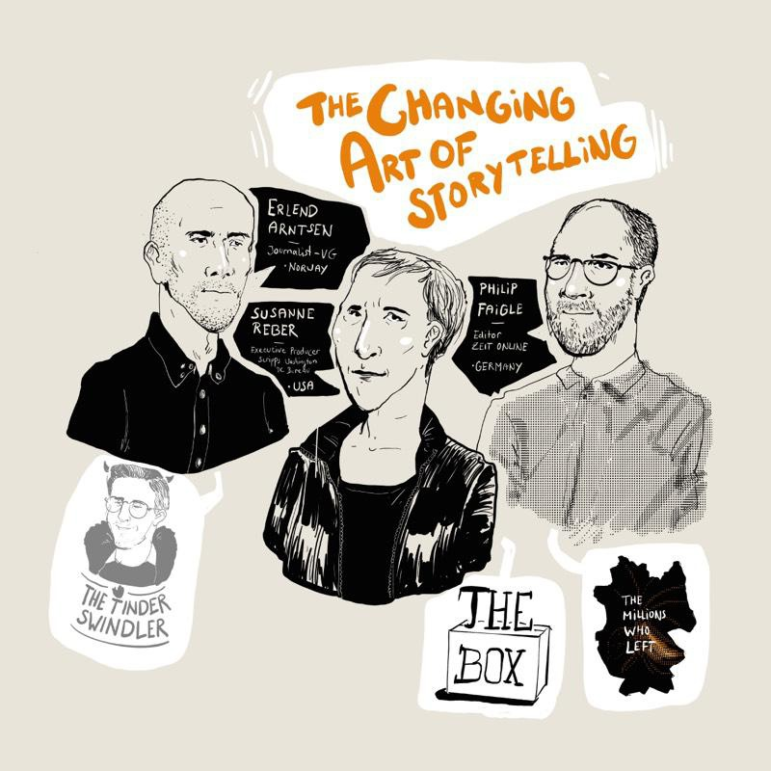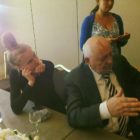
Illustration: Phil Ninh
From podcasts and the latest mobile-friendly formats, to storytelling with games and virtual reality, new ways of engaging audiences in investigative journalism are emerging quickly.
At the 11th Global Investigative Journalism Conference in Hamburg, speakers from Norway, Germany, and the United States shared their experiences with creating engaging and compelling stories about anything from a swindler on Tinder to earthquakes in Oklahoma and the demographic crisis in eastern Germany, while staying true to investigative journalism.
The Tinder Swindler: A Smartphone Story
How did an Israeli man seduce and con several women in the Nordics out of millions of dollars using Tinder?
In February 2019, the Norwegian newspaper VG produced the complex, six-month investigation “The Tinder Swindler,” revealing the story of a con artist who met his victims through Tinder. The story attracted more than 2 million readers, with 50% of the readers reading the investigation all the way to the end, prompting numerous follow-ups by global media houses.
It was an investigative and visual story of, by and for the smartphone, said Erlend Arntsen, journalist at VG.
Using text bridges, sounds, short video clips, as well as reconstructing WhatsApp dialogues, VG documented his scammer trail. All readers had to do was scroll. Personalizing the story was a must, Arntsen explained. “We had to make the readers understand how these women fell in love with the scammer.”
Using Animation and Data Sonification
Audiences are mobile, and they want new experiences, to control when and how they watch and listen, and they demand high production value, said Susanne Reber, executive producer at Scripps Washington DC Bureau.
“Always ask yourself: Who is your audience, and how will they experience the story,” she said, sharing several examples on how to bring investigations and data to life in a new way.
Her first example was the The Box, an animated story about Ismael “Izzy” Nazario and his time in solitary confinement in New York City’s Rikers Island. The story was based on a larger investigation by The Center for Investigative Reporting on juveniles in solitary confinement in the US.
“We had a great source, but no access to him. Using an innovative format with animation, audio, and music allowed us to tell the story and reach a younger audience,” Reber explained.
Another example was Oklahoma’s earthquake. Reveal took 10 years of Oklahoma earthquake data, translated it into MIDI notes, and ran those through a synthesizer, sharing the seismic activity during the radio show.
Reber also talked about Sold In America, an eight-episode podcast about sex trafficking in the United States. By providing a phone number to the audience, thousands of listeners engaged directly with the team behind the podcast during the journey.
“Involving your audience in a real conversation pays off in potential content and gives them a stake in your story,” she said.
Teaming Up
Create a small team, find new ways of storytelling, and then introduce it to the rest of the newsroom, said Philip Faigle, special projects editor at Zeit Online.
“Also make sure the relevant people work closely together, such as the web developer, head of visual journalism, designer, data journalist, and data scientist,” he said, showing some examples of innovative projects from Zeit.
In the story “The Millions Who Left,” the team used data to show the demographic crisis unfolding in eastern Germany following German reunification in 1990.
The project “123 Stimmen Der Jugend” gave voice to the German youth; “Drei von 140 Millionen” tells the story of three children born in Colombia, Norway, and Mongolia; while in the story “The Stasi Played Along,” readers would experience how it was to be spied on by the GDR’s notorious State Security Service, also known as Stasi.
 Anne Sofie Hoffmann Schrøder is a Danish investigative journalist. Her work has appeared in Deutsche Welle, Euronews, Agência de Notícias das Favelas, and various Scandinavian and German outlets. She reports on corruption, machismo culture, and migration in Latin America, and trolls, disinformation, and politics in Europe. A grantee of Journalismfund and Robert Bosch Stiftung, she interviewed Mikhail Gorbachev.
Anne Sofie Hoffmann Schrøder is a Danish investigative journalist. Her work has appeared in Deutsche Welle, Euronews, Agência de Notícias das Favelas, and various Scandinavian and German outlets. She reports on corruption, machismo culture, and migration in Latin America, and trolls, disinformation, and politics in Europe. A grantee of Journalismfund and Robert Bosch Stiftung, she interviewed Mikhail Gorbachev.
